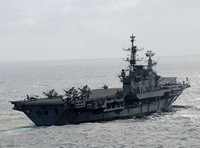China’s four-week standoff with the Philippines in May over the disputed Scarborough Shoal in the South China Sea has brought the issue of Asian naval rivalry back to center stage. The anxiety is not confined to China’s neighbors in Southeast Asia, however. Maritime experts in India now worry about the increasing frequency and size of Chinese maritime contingents deployed in anti-piracy patrols off Somalia and the increasingly assertive stance adopted by China’s maritime policy community, no longer coy about discussing naval bases in the Indian Ocean. But if New Delhi is most concerned about China’s forays into the Indian Ocean, it has not ignored developments in the South China Sea.
India’s “Look East” policy has been in force for more than two decades now. Originally devised as a strategy to boost trade and foster economic cooperation with Southeast Asia, the policy has more recently acquired a prominent maritime edge. Over the past few years, India’s political leadership has stressed repeatedly that it is in favor of “freedom of navigation” and an open and inclusive architecture of global maritime security. In his address at the recently concluded Shangri-La Dialogue in Singapore, Indian Defense Minister A.K. Antony noted that open sea lanes in the South China Sea were critical for global commerce and that “maritime freedoms could not be the exclusive prerogative of a few.” Indian officials reiterated this theme during U.S. Defense Secretary Leon Panetta’s visit to New Delhi in early June.
While the Indian navy continues to actively participate in anti-piracy efforts in the western Indian Ocean and has expanded its operational interactions with its closest exercise partner, the U.S. Navy, it is gradually turning its attention to the security of sea lines of communications in the east. In 2011, the Indian navy began a process of sprucing up its eastern defenses. As part of the upgrade program, frontline warships and the landing platform dock INS Jalashawa were based in the Eastern Naval Command. The Indian navy now plans to base its new stealthy Shivalik-class frigates on the east coast and is also considering deploying unmanned aerial vehicles and multimission maritime aircraft there as well. The blueprint for setting up operational turnaround facilities in the eastern ports of Pardeep and Tuticorin is also reportedly ready. The Indian navy frames the operational overhaul of its eastern defenses in benign terms, calling it a long overdue refurbishment of critical infrastructure, but the shift in strategic focus is all too perceptible.

